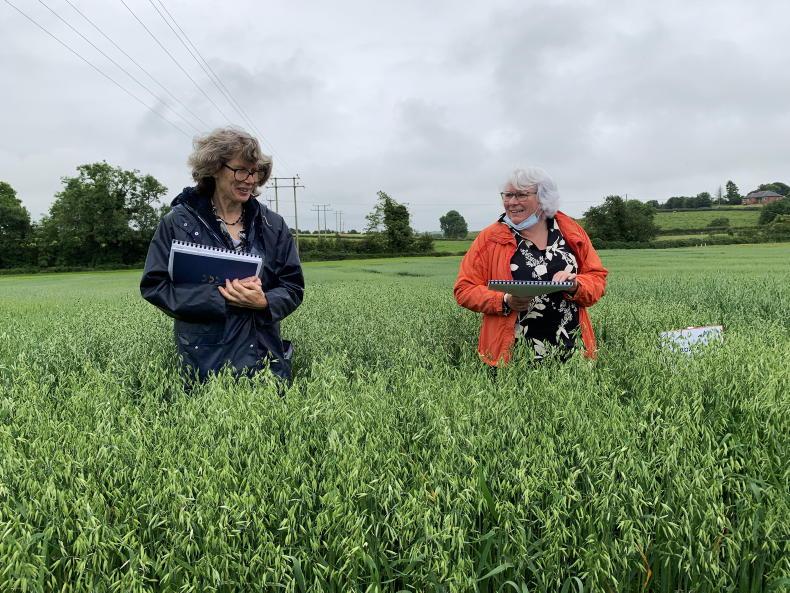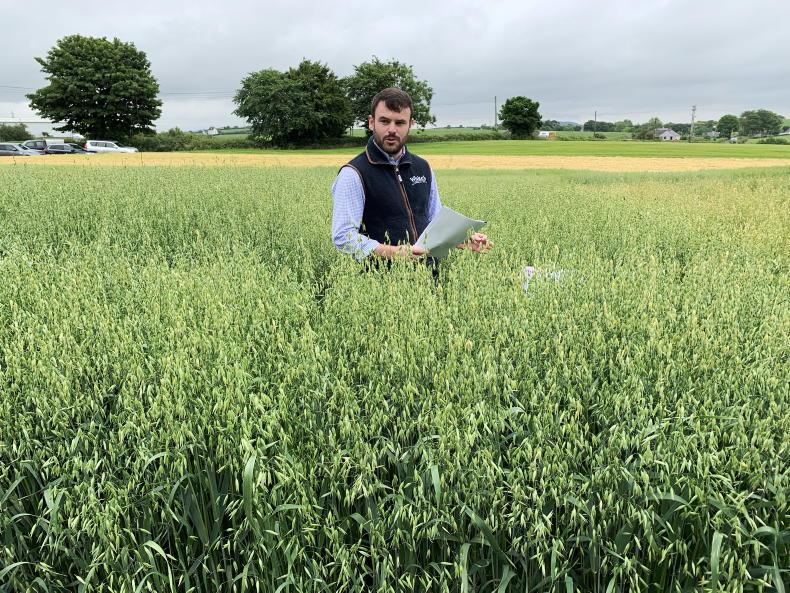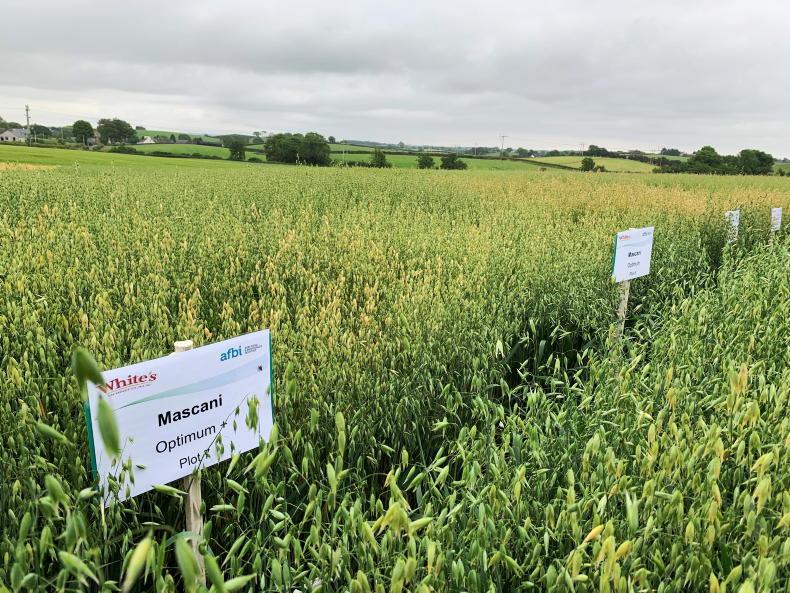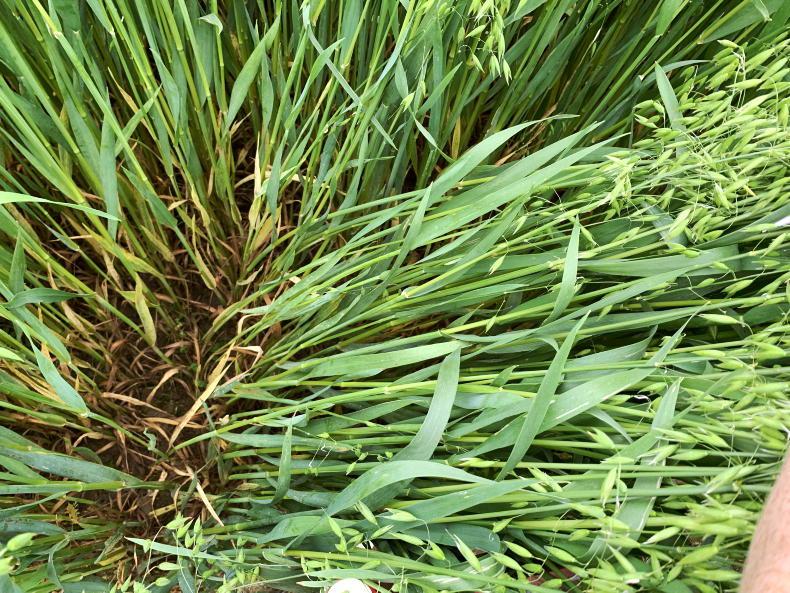Sowing spring oat varieties in the autumn is common practice across the Republic of Ireland.
Spring varieties sown in the autumn can offer advantages over true winter oat varieties, including higher yields, higher quality, earlier harvest and typically easier-managed straw.
However, this practice is much less common in Northern Ireland (NI), where growers tend to grow true winter oat varieties.
This limits the autumn variety options for NI growers, particularly for those supplying the milling market.

Ethel White, along with afbi’s Lisa Black, gave a run through of the various winter and spring oat varieties on the day.
As a result, NI oat miller White’s Oats has been working closely with the Agri-Food and Biosciences Institute (afbi) to compare the performance of the autumn-sown spring oat variety Husky with true winter oat variety Mascani under NI conditions.
White’s held its annual growers day last week, where researchers presented the results from some of their trial work, which is now in its third year.
Across the various trials and treatments, the results are proving promising for Husky, which is consistently out-yielding Mascani.
Interestingly, low-input Husky trials (120kg N/ha) out-yielded higher input Mascani (160kg N/ha) by over 0.5t/ac in both 2019 and 2020.
Kernel content was variable between the two varieties, with Husky outperforming Mascani in 2020 and Mascani coming out on top in 2019. Husky had higher bushel weight but screenings were also marginally higher.
While work is ongoing at trial sites across NI, White’s Oats has also developed a platform for growers to share and compare crop performance data from their own oat crops.
Sean Kane, agri supply chain coordinator with White’s, explained that some growers are achieving considerably higher yields and quality than others.
The idea of the platform will be to learn what these growers are doing differently and in time, share it among the group of growers.

Whites Oat’s Sean Kane gave a run through of the Husky and Mascani trails plots on the day.
When it comes to milling oats, there are a number of key quality parameters that have an important influence.
Targeting hullability and milling quality
Experience and research have both shown that higher nitrogen rates on oats tend to have a negative effect on grain quality. In this regard, we normally refer to grain quality as its specific weight, bushel weight or hectolitre weight.
But White’s has decided that this is not an appropriate measure of milling quality in oats.
The food oat market involves the removal of the husk from the kernel to give the meal. So, the ease with which the husk, hull or seed coat can be removed from a grain is a critical factor in its suitability for milling.
While there are a number of factors that influence hullability, variety is probably the single most important, but we must now ask if nitrogen is also a factor.
To help answer this question, White’s is conducting research in conjunction with afbi to look at different varieties, rates and timings of nitrogen and the presence or absence of growth regulator treatment. These are all being examined to assess their impact on grain yield and the milling characteristics of the oats produced by the different treatments. The objective is to help determine the impact of agronomic factors on hullability.
The experiment is being carried out using two spring varieties – Husky and Isabel. Both varieties are quite suitable for milling and the research is assessing if they respond in the same way to nitrogen and growth regulator, in terms of yield and milling quality.
Hullability
This is a measure of the ease with which the husk of oats can be removed from the kernel inside. It also affects the efficiency with which oats can be milled. The mills use a mechanical process that throws the grains at high speed against a stationary object, which should cause the kernels to be ejected. Variety seems to have a major effect and differences between varieties appear to be largely consistent from site to site and from year to year.
The oat plant produces a panicle, rather than a spike or ear, and the grains are formed in spikelets on the branches of the panicle. Each spikelet can have a varying number of grains – two is normal and three is also common.
Within the spikelet, individual grains are regarded as being primary, secondary or tertiary.
Having a lot of tertiary grains (the third grain in the spikelet) will frequently result in higher screenings and losses and the secondary grains are regarded as easier to dehull than primary grains.
This study highlights the need for an investigation into the effects of agronomic factors on hullability.
The role of nitrogen
The canopy in oats appears to have a limited ability to produce extra photosynthate to fill more grains, if they exist. That is one of the reasons why blasting or sterility in the panicle is often seen in oats post-heading – at some point previously, the plant decided that it could not fill so many grains adequately, based on some growth limitation at that time.
Early nitrogen drives vegetative growth and a well-fed plant during those early growth stages will often produce a bigger panicle and more grains per spikelet.
This signals the potential for higher yield, but if the plant subsequently realises that it cannot fill them all adequately, it will abort some spikelets, normally towards the base of the panicle.

There was a range of oat trials to see on the day.
The remaining spikelets that had formed three grains will continue to carry all three. But the third grain can be small and poorly filled, resulting in lower specific weight and higher screenings.
Both screenings and grains that will not dehull are a loss in the milling process and so these efforts to hone husbandry towards maximum milling yield are important to growers and millers.
Specific weight versus
kernel quality
Specific weight is the weight of a given volume. This could be a test apparatus (called a chondrometer), a loader bucket, a trailer or a ship’s hold. It is influenced by the weight of the grain and the characteristics of the seed coat or hull that affect its ability to pack tightly, or not. Nitrogen rate and timing can influence specific weight, possibly due to making more grains of variable size that pack less well.

Growers and members of the trade inspecting a Mascani trial plot.
But for a miller, it is the kernel inside of the seed coat or hull that produces the product to be sold – the oatmeal.
Therefore, kernel content and kernel yield are much more important. Things that reduce kernel yield, such as poor hullability and screenings, need to be avoided and this research will hopefully throw light on at least some of these factors.
Another focus of the day was to highlight some of the challenges facing the NI tillage industry. One area covered was the impact of Brexit on the NI seed supply chain.
Much attention has been given to issues associated with British potato seed, as it is now completely banned from entering the EU and NI. However, little has been said about the impact Brexit has had on cereal seed.
Britain has left the customs union and single market and is now regarded as a third country. EU plant health rules in the area of intra-union trade in plants and plant products no longer apply.
Under the EU–UK Trade and Cooperation Agreement, cereal and other grain seeds are allowed to be imported from Britain to the EU. This also applied to Northern Ireland, due to the NI Protocol.
However, the additional phytosanitary, testing and labelling requirements mean that the process is complex and has the potential to cause difficulties and delays when importing British seed.

It was a relatively low disease pressure year in Crossnacreevy and treated plots remained very clean.
To put this in context, Jonathan Dunn, agronomy and forage services manager with Fane Valley, explained how their seed supply chain has had to rapidly adapt to the new trading landscape.
NI growers produce a small amount of seed, mostly barley and oats. Jonathan explains that in this case, locally produced seed can be ready for sale anywhere from two to nine days after certification. Certification is carried out by afbi.
However, a significant proportion of NI’s cereal seed requirements has traditionally been sourced in England.
It typically took between five and 10 days to import certified seed across the Irish Sea pre-Brexit. However, this process now takes 19 working days on average, he says.
Red tape
English seed is certified in Britain and this process remains unchanged. However, the challenge begins with the additional certification requirements for third country seed.
All lots of English seed imported into the EU and NI require a phytosanitary certificate. This process is completed in England and generally takes seven working days at a cost of £180 for each lot.
The cost of this is currently being covered by Westminister for a two-year period, but will likely be incurred by the grower when this expires.
Simultaneously, another certification process gets under way. The Organisation for Economic Co-operation and Development (OECD) Seed Certification Scheme is a global framework for the varietal certification of internationally traded seed.
British seed exports must now be certified again under the OECD, which takes place in the NIAB laboratory in Cambridge or the SRUC laboratory in Scotland. This process also typically takes seven working days.
Each individual bag of seed will require an OECD certification label at a cost of £0.20.
Once at Belfast port, the seed must go through the necessary documentary checks and inspections, which can take one to three days.
Assuming all documents are in order, the seed is cleared to enter NI and make its way to the seed plant for recleaning or dressing before delivery to farm.
Supply chains
These new challenges have fundamentally changed merchant seed supply chains, explains Jonathan.
NI merchants have had to secure more of their cereal seed from ROI and indeed, some expect to increase the area of locally grown seed. Many growers are also likely to increase their home-saved seed tonnages.
However, these measures have their limitations and aren’t really a solution for wheat varieties in particular.
To overcome some of the additional red tape, costs and delays, some seed has been secured from as far away as France, as these new rules and regulations do not apply to continental EU countries.
However, finding suitable varieties on the continent will be a challenge.
It could be argued that a reduction in English seed, which carries a higher risk of grass weed contamination when compared to native seed, is good for the farming community on the entire island.
However, at grower level, this will likely just result in reduced availability of certain varieties and increased cost.
So, the message from the trade on the day was clear. In order to ensure seed supplies are landed on the island on time, order as early as possible.
Sowing spring oat varieties in the autumn is common practice across the Republic of Ireland.
Spring varieties sown in the autumn can offer advantages over true winter oat varieties, including higher yields, higher quality, earlier harvest and typically easier-managed straw.
However, this practice is much less common in Northern Ireland (NI), where growers tend to grow true winter oat varieties.
This limits the autumn variety options for NI growers, particularly for those supplying the milling market.

Ethel White, along with afbi’s Lisa Black, gave a run through of the various winter and spring oat varieties on the day.
As a result, NI oat miller White’s Oats has been working closely with the Agri-Food and Biosciences Institute (afbi) to compare the performance of the autumn-sown spring oat variety Husky with true winter oat variety Mascani under NI conditions.
White’s held its annual growers day last week, where researchers presented the results from some of their trial work, which is now in its third year.
Across the various trials and treatments, the results are proving promising for Husky, which is consistently out-yielding Mascani.
Interestingly, low-input Husky trials (120kg N/ha) out-yielded higher input Mascani (160kg N/ha) by over 0.5t/ac in both 2019 and 2020.
Kernel content was variable between the two varieties, with Husky outperforming Mascani in 2020 and Mascani coming out on top in 2019. Husky had higher bushel weight but screenings were also marginally higher.
While work is ongoing at trial sites across NI, White’s Oats has also developed a platform for growers to share and compare crop performance data from their own oat crops.
Sean Kane, agri supply chain coordinator with White’s, explained that some growers are achieving considerably higher yields and quality than others.
The idea of the platform will be to learn what these growers are doing differently and in time, share it among the group of growers.

Whites Oat’s Sean Kane gave a run through of the Husky and Mascani trails plots on the day.
When it comes to milling oats, there are a number of key quality parameters that have an important influence.
Targeting hullability and milling quality
Experience and research have both shown that higher nitrogen rates on oats tend to have a negative effect on grain quality. In this regard, we normally refer to grain quality as its specific weight, bushel weight or hectolitre weight.
But White’s has decided that this is not an appropriate measure of milling quality in oats.
The food oat market involves the removal of the husk from the kernel to give the meal. So, the ease with which the husk, hull or seed coat can be removed from a grain is a critical factor in its suitability for milling.
While there are a number of factors that influence hullability, variety is probably the single most important, but we must now ask if nitrogen is also a factor.
To help answer this question, White’s is conducting research in conjunction with afbi to look at different varieties, rates and timings of nitrogen and the presence or absence of growth regulator treatment. These are all being examined to assess their impact on grain yield and the milling characteristics of the oats produced by the different treatments. The objective is to help determine the impact of agronomic factors on hullability.
The experiment is being carried out using two spring varieties – Husky and Isabel. Both varieties are quite suitable for milling and the research is assessing if they respond in the same way to nitrogen and growth regulator, in terms of yield and milling quality.
Hullability
This is a measure of the ease with which the husk of oats can be removed from the kernel inside. It also affects the efficiency with which oats can be milled. The mills use a mechanical process that throws the grains at high speed against a stationary object, which should cause the kernels to be ejected. Variety seems to have a major effect and differences between varieties appear to be largely consistent from site to site and from year to year.
The oat plant produces a panicle, rather than a spike or ear, and the grains are formed in spikelets on the branches of the panicle. Each spikelet can have a varying number of grains – two is normal and three is also common.
Within the spikelet, individual grains are regarded as being primary, secondary or tertiary.
Having a lot of tertiary grains (the third grain in the spikelet) will frequently result in higher screenings and losses and the secondary grains are regarded as easier to dehull than primary grains.
This study highlights the need for an investigation into the effects of agronomic factors on hullability.
The role of nitrogen
The canopy in oats appears to have a limited ability to produce extra photosynthate to fill more grains, if they exist. That is one of the reasons why blasting or sterility in the panicle is often seen in oats post-heading – at some point previously, the plant decided that it could not fill so many grains adequately, based on some growth limitation at that time.
Early nitrogen drives vegetative growth and a well-fed plant during those early growth stages will often produce a bigger panicle and more grains per spikelet.
This signals the potential for higher yield, but if the plant subsequently realises that it cannot fill them all adequately, it will abort some spikelets, normally towards the base of the panicle.

There was a range of oat trials to see on the day.
The remaining spikelets that had formed three grains will continue to carry all three. But the third grain can be small and poorly filled, resulting in lower specific weight and higher screenings.
Both screenings and grains that will not dehull are a loss in the milling process and so these efforts to hone husbandry towards maximum milling yield are important to growers and millers.
Specific weight versus
kernel quality
Specific weight is the weight of a given volume. This could be a test apparatus (called a chondrometer), a loader bucket, a trailer or a ship’s hold. It is influenced by the weight of the grain and the characteristics of the seed coat or hull that affect its ability to pack tightly, or not. Nitrogen rate and timing can influence specific weight, possibly due to making more grains of variable size that pack less well.

Growers and members of the trade inspecting a Mascani trial plot.
But for a miller, it is the kernel inside of the seed coat or hull that produces the product to be sold – the oatmeal.
Therefore, kernel content and kernel yield are much more important. Things that reduce kernel yield, such as poor hullability and screenings, need to be avoided and this research will hopefully throw light on at least some of these factors.
Another focus of the day was to highlight some of the challenges facing the NI tillage industry. One area covered was the impact of Brexit on the NI seed supply chain.
Much attention has been given to issues associated with British potato seed, as it is now completely banned from entering the EU and NI. However, little has been said about the impact Brexit has had on cereal seed.
Britain has left the customs union and single market and is now regarded as a third country. EU plant health rules in the area of intra-union trade in plants and plant products no longer apply.
Under the EU–UK Trade and Cooperation Agreement, cereal and other grain seeds are allowed to be imported from Britain to the EU. This also applied to Northern Ireland, due to the NI Protocol.
However, the additional phytosanitary, testing and labelling requirements mean that the process is complex and has the potential to cause difficulties and delays when importing British seed.

It was a relatively low disease pressure year in Crossnacreevy and treated plots remained very clean.
To put this in context, Jonathan Dunn, agronomy and forage services manager with Fane Valley, explained how their seed supply chain has had to rapidly adapt to the new trading landscape.
NI growers produce a small amount of seed, mostly barley and oats. Jonathan explains that in this case, locally produced seed can be ready for sale anywhere from two to nine days after certification. Certification is carried out by afbi.
However, a significant proportion of NI’s cereal seed requirements has traditionally been sourced in England.
It typically took between five and 10 days to import certified seed across the Irish Sea pre-Brexit. However, this process now takes 19 working days on average, he says.
Red tape
English seed is certified in Britain and this process remains unchanged. However, the challenge begins with the additional certification requirements for third country seed.
All lots of English seed imported into the EU and NI require a phytosanitary certificate. This process is completed in England and generally takes seven working days at a cost of £180 for each lot.
The cost of this is currently being covered by Westminister for a two-year period, but will likely be incurred by the grower when this expires.
Simultaneously, another certification process gets under way. The Organisation for Economic Co-operation and Development (OECD) Seed Certification Scheme is a global framework for the varietal certification of internationally traded seed.
British seed exports must now be certified again under the OECD, which takes place in the NIAB laboratory in Cambridge or the SRUC laboratory in Scotland. This process also typically takes seven working days.
Each individual bag of seed will require an OECD certification label at a cost of £0.20.
Once at Belfast port, the seed must go through the necessary documentary checks and inspections, which can take one to three days.
Assuming all documents are in order, the seed is cleared to enter NI and make its way to the seed plant for recleaning or dressing before delivery to farm.
Supply chains
These new challenges have fundamentally changed merchant seed supply chains, explains Jonathan.
NI merchants have had to secure more of their cereal seed from ROI and indeed, some expect to increase the area of locally grown seed. Many growers are also likely to increase their home-saved seed tonnages.
However, these measures have their limitations and aren’t really a solution for wheat varieties in particular.
To overcome some of the additional red tape, costs and delays, some seed has been secured from as far away as France, as these new rules and regulations do not apply to continental EU countries.
However, finding suitable varieties on the continent will be a challenge.
It could be argued that a reduction in English seed, which carries a higher risk of grass weed contamination when compared to native seed, is good for the farming community on the entire island.
However, at grower level, this will likely just result in reduced availability of certain varieties and increased cost.
So, the message from the trade on the day was clear. In order to ensure seed supplies are landed on the island on time, order as early as possible.











 This is a subscriber-only article
This is a subscriber-only article











SHARING OPTIONS: